Lemur leaf frogs, Costa Rica
This small, bright yellow-green frog species is native to Central America.
They are critically endangered, their numbers in the wild have fallen by 80% over the past 15 years owing to chytridiomycosis – a fungal disease caused by the chytrid fungus, which has attacked amphibians across the world.
Lemur leaf frogs are now known to occur naturally only in a single site in Costa Rica, on the edge of the Veragua rainforest reserve in Limon province. This suggests that these tiny, charismatic frogs have either undergone a significant range contraction or occur more sparsely than previously recorded. However, they have been introduced to new sites in the region, where they appear to be thriving.
The chytrid fungus is widespread in Costa Rica and represents perhaps the greatest threat to amphibian survival.
Bristol Zoological Society (BZS) is working with a number of organisations on this project, to determine the population size of these distinctive frogs and to discover more precisely where they are living. We are also working on pond restoration and creation efforts to increase breeding habitat for the animals in their natural range.
The study has won praise from the naturalist and broadcaster Sir David Attenborough, who said: “I wholeheartedly support the campaign to save the lemur leaf frog. It is, after all, one of the world’s most unusual and rarest amphibians – and it is in real trouble.”
Bristol zoo gardens (BZG) is home to a breeding group of lemur leaf frogs, held in a sterile, climate-controlled “amphipod”. The zoo also manages the European conservation breeding programme for the species.
Lemurs, northern Madagascar

BZS is working on the conservation of threatened lemurs and the ibis bird in north-west Madagascar, as well as the protection and restoration of their habitats.
The blue-eyed black lemur from the Sahamalaza peninsula is considered the most charming of the lemur species, the males being jet-black and the females golden-orange, with both sexes having striking turquoise eyes.
Bristol zoo gardens is home to a pair of blue-eyed black lemurs. The species is critically endangered in the wild owing to hunting and habitat loss. It was listed as one of the world’s 25 most endangered primates between 2008 and 2014, and numbers in the wild are unknown.
BZS is working to safeguard this species in a number of ways. Our project is determining the most effective way to replant forest in the lemurs’ habitat to increase forest cover in the national park.
In addition, we are working alongside like-minded organisations to improve the livelihoods of rural poor Malagasy communities. We also contribute to maintaining a population of the blue-eyed black lemur in human care.
These actions have helped to secure the future of the species in Madagascar, and, while still heavily conservation-dependent, the blue-eyed black lemur was removed from the list of the world’s most endangered primates in 2014.
Kordofan giraffe, Cameroon
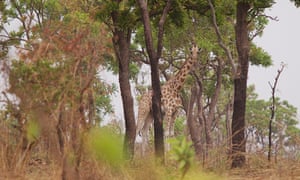
As one of the world’s most beautiful and majestic animals, giraffe are instantly recognisable and loved the world over.
But this striking creature is quietly slipping towards extinction. Kordofan giraffe are one of nine giraffe subspecies and, despite being one of the most populous giraffe in zoos, the situation facing them in the wild is challenging. As such, the conservation of Kordofan giraffe is becoming a race against time.
It is estimated that as few as 2,000 Kordofan giraffe may be left in Africa, out of a total giraffe population of about 80,000. Poaching, bushmeat trade and habitat loss are the main threats to their future in the wild.
BZS leads a vital conservation project for the species, which focuses on protecting one of the few remaining populations of Kordofan giraffe left in the wild, in Benoue national park, northern Cameroon.
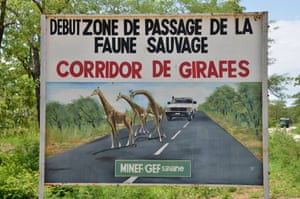
A team of BZS conservationists has been working to determine how many giraffe remain in the park. Drones have enabled eco-guards to search larger areas in order to establish giraffe population numbers and locations. More recently, motion-activated camera traps have also been set up to monitor wildlife in the area.
Wild Place Project, the sister site of Bristol zoo gardens in south Gloucestershire, is home to three reticulated giraffe.
Western lowland gorillas, Central Africa

BZS recently launched a flagship conservation project in Equatorial Guinea to protect one of Africa’s most threatened great ape species, western lowland gorillas.

The society’s conservation team is collaborating with the University of the West of England to create a research base in Monte Alen national park, where conservationists from the zoo will focus their efforts on protecting western lowland gorillas.
The exact number of western lowland gorillas in the wild is not known because they inhabit some of the densest and most remote rainforests in Africa.
In 2005, it was estimated that about 2,000 individuals lived in the Monte Alen national park, but today’s numbers are unknown.
The species is threatened with habitat loss from deforestation and the threat of bushmeat hunting. As a result, researchers estimate that gorilla numbers overall have declined by more than 60% over the last 20 to 25 years.
Their dwindling numbers are reflected across five other African countries: Angola, Cameroon, Central African Republic, the Republic of the Congo and Gabon. Recent estimates suggest as few as 360,000 remain across these countries.
Bristol zoo gardens is home to seven western lowland gorillas. The zoo is part of a European breeding programme for the species, to ensure there is a strong population in human care.
White-clawed crayfish, UK

The UK’s only native freshwater crayfish is a keystone species of our aquatic habitats. It is globally endangered throughout its range, both within mainland Europe and the UK.
Since the 1970s, there has been more than a 70% decline in numbers in south-west England owing to habitat fragmentation, pollution and, most importantly, the introduction of the non-native invasive signal crayfish. The latter carries crayfish plague, a disease which is lethal to the native UK species.
For more than 10 years, our dedicated team have been breeding white-clawed crayfish in a hatchery at Bristol zoo gardens. It was the first white-clawed crayfish hatchery in the UK; however we are now working with partners to establish others throughout the south-west. Once hatched, they are reintroduced into safe ark sites across the south-west by our native species conservation team.
Socorro doves, conservation breeding programme

The species is extinct in the wild. BZS has five individuals, two at Bristol zoo gardens and three at Wild Place. There are only about 200 Socorro doves in captivity worldwide.
The last known sighting of a Socorro dove in the wild was in 1972. Now there are just 29 birds in eight UK zoos. Coordinated conservation breeding of the birds by zoos such as Bristol zoo and Wild Place has prevented the total extinction of the species.
Socorro doves were native to the island of Socorro, 600 miles off the western coast of Mexico. They died out after falling prey to a rising number of feral cats in the area. In addition, overgrazing by sheep destroyed much of their forest floor habitat and the birds were hunted by humans for food.
Desertas wolf spiders, Madeira, Portugal

This species of spider is a critically endangered and is only found in one valley on one of the Desertas islands near Madeira. Despite having an impressive 40mm body size and being the largest known wolf spider, very little is known about this species.
Bristol zoo gardens’ successful breeding programme has seen the creation of nine new captive populations set up at other institutions from spiders reared at Bristol zoo.
In the wild, the absence of any native terrestrial mammals means this spider is a top predator in its habitat. Although its major prey consists of other invertebrates, such as beetles, millipedes and woodlice, adults have also been seen predating on juvenile lizards.
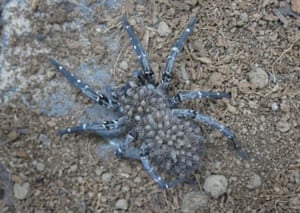
The small valley where the spider lives is covered by a fast growing grass, Phalaris. The colonisation of this grass in the Vale da Castanheira was hidden for some years owing to the presence of rabbits that grazed and controlled the spread of the plant.
With the eradication of rabbits from the valley in 1996, the Phalaris grass lost its main predator and now proliferates. This grass appears to not only displace many other native plants, but also many of the native animals. It covers the surface of the soil and rocks, making the microhabitats below the rocks harder to access for the spiders.
Bristol zoo and its invertebrates team were the pioneers for the world’s first captive breeding programme for Desertas wolf spiders in 2017, and there has since been the hatching of more than 750 spiderlings.
Now a European breeding programme for the species is being coordinated by B ZS, combined with a conservation action plan to help save the species in the wild. We also work closely with the Madeiran government, which is leading on the habitat restoration aspects of this conservation programme.
African penguins, South Africa
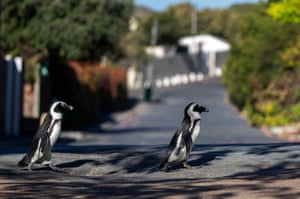
The wild population of endangered African penguins has been monitored by BZS and partner organisations for 14 years in South Africa.
The global population of African penguins fell by 70% between 2001 and 2013, leaving approximately 18,000 to 22,000 breeding pairs in the wild. The main causes of this decline are overfishing off the coast of South Africa and Namibia, and climate change.
BZS’s African penguin conservation project consists of three main areas. The first is to work with a local rehabilitation centre, the Southern African Foundation for the Conservation of Coastal Birds (SANCCOB ), to rescue, rear and release abandoned penguin chicks once they reach a healthy weight at fledging age.
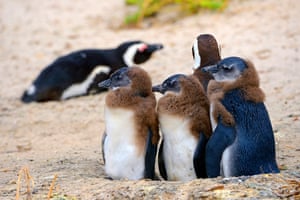
The second is to participate in a long-term monitoring programme of wild African penguins at a key breeding colony on Robben Island. As part of this, we are trying to understand how immature African penguins choose breeding sites – something that is currently very poorly understood.
Third, the project aims to analyse the movement and ecology of penguins at all life stages, to better understand how they choose and use breeding colonies.
A dedicated team track penguins to understand how they are affected by threats such as overfishing and climate change, allowing BZS to provide crucial data to the South African government. This data can be used to determine the best size and location for future marine protected areas.
Sanje mangabeys, Tanzania
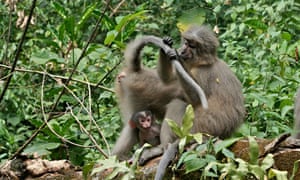
There are seven recognised species of Cercocebus mangabeys. All are at high risk of extinction and all are relatively understudied, owing to the fact that they are usually found deep in the forest, in regions that are difficult to access and not often visited by tourists or researchers.
BZS is monitoring the population of the Sanje mangabey monkey and working to understand the threats to their survival in the Udzungwa Mountains in Tanzania.
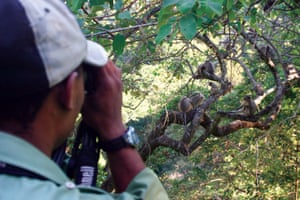
Mangabeys are highly terrestrial, spending large amounts of time on the forest floor rather than up in the trees. The species is listed as endangered owing to declining population size, habitat loss and forest fragmentation. In the last 15 years it is estimated that the population has declined by 31%, leaving a total of only 3,000 monkeys remaining in the world.
BZS is working with local and international stakeholders to ensure the protection of the Sanje mangabey and its remaining habitat.
Bleeding-heart doves, the Philippines
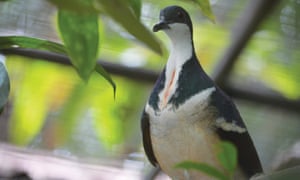
The beautiful yet elusive Negros bleeding-heart dove is among the rarest bird species in the world and is native to the Western Visayas islands of Negros and Panay in the Philippines.
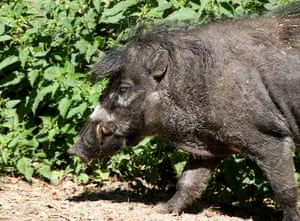
The Philippines are considered to be one of the world’s diverse biodiversity hotspots because of the amazing variety of wildlife there. Yet 50% of the country’s forests have already been cut down, mainly to grow crops.
So-called for their bright, blood-red chest patch, these birds need high-quality, low elevation tropical forests to survive. Now it is feared there are fewer than 300 pairs of Negros bleeding-heart doves left in the wild. As such, this species has been categorised as critically endangered on the IUCN red list of threatened species.
BZS has been working in the Philippines since 2000 and, last year, was able to catch a rare glimpse of the bird and record it on film for the first time in more than a decade.
By conserving this species and its habitat, a number of other rare and threatened species are also benefiting, including Visayan warty pigs (left).